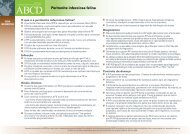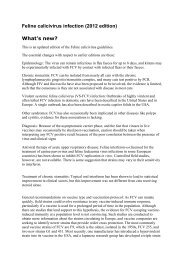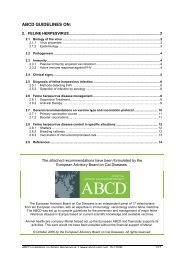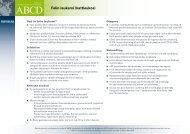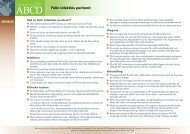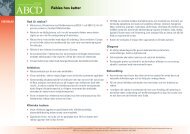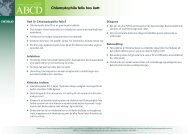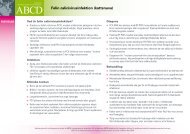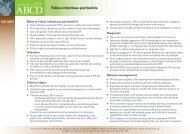abcd guidelines on - The European Advisory Board on Cat Diseases
abcd guidelines on - The European Advisory Board on Cat Diseases
abcd guidelines on - The European Advisory Board on Cat Diseases
Create successful ePaper yourself
Turn your PDF publications into a flip-book with our unique Google optimized e-Paper software.
ABCD GUIDELINES ON:<br />
1. FELINE PANLEUKOPENIA.................................................................................3<br />
1.1 Virus ......................................................................................................................................................3<br />
1.1.1 Epidemiology..................................................................................................................................3<br />
1.2 Pathogenesis .......................................................................................................................................4<br />
1.2.1 Immunopathogenesis of FPV infecti<strong>on</strong> ........................................................................................4<br />
1.2.2 Passive immunity acquired via colostrum ....................................................................................5<br />
1.2.3 Active immune resp<strong>on</strong>se against FPV .........................................................................................6<br />
1.3 Diagnosis of feline parvovirus infecti<strong>on</strong>.........................................................................................6<br />
1.4 Feline panleukopenia disease management ..................................................................................7<br />
1.5 General recommendati<strong>on</strong>s <strong>on</strong> vaccine type and vaccinati<strong>on</strong> protocol.....................................8<br />
1.5.1 Primary vaccinati<strong>on</strong> course ...........................................................................................................8<br />
1.5.2 Booster vaccinati<strong>on</strong>s......................................................................................................................9<br />
1.6 Feline Panleukopenia c<strong>on</strong>trol in specific situati<strong>on</strong>s.....................................................................9<br />
1.6.1 Shelters...........................................................................................................................................9<br />
1.6.2 Breeding catteries ....................................................................................................................... 11<br />
1.6.3 Vaccinati<strong>on</strong> of immunocompromised cats ................................................................................ 11<br />
1.7 References ........................................................................................................................................ 12<br />
<strong>The</strong> attached recommendati<strong>on</strong>s have been formulated by the<br />
<strong>European</strong> <strong>Advisory</strong> <strong>Board</strong> <strong>on</strong> <strong>Cat</strong> <strong>Diseases</strong>.<br />
<strong>The</strong> <strong>European</strong> <strong>Advisory</strong> <strong>Board</strong> <strong>on</strong> <strong>Cat</strong> <strong>Diseases</strong> is an independent panel of 17 veterinarians<br />
from ten <strong>European</strong> countries, with an expertise in immunology, vaccinology and/or feline medicine.<br />
<strong>The</strong> ABCD was set up to compile <str<strong>on</strong>g>guidelines</str<strong>on</strong>g> for the preventi<strong>on</strong> and management of major feline<br />
infectious disease in Europe based <strong>on</strong> current scientific knowledge and available vaccines.<br />
Animal healthcare company Merial helped set up the <strong>European</strong> ABCD and financially supports its<br />
activities. This work would not have been possible without the financial support of Merial.<br />
© July 2006 by the <strong>European</strong> <strong>Advisory</strong> <strong>Board</strong> <strong>on</strong> <strong>Cat</strong> <strong>Diseases</strong>. All rights reserved.<br />
ABCD <str<strong>on</strong>g>guidelines</str<strong>on</strong>g> <strong>on</strong> Feline Panleukopenia Virus (www.<str<strong>on</strong>g>abcd</str<strong>on</strong>g>-vets.org), June 2006 1/15
ABCD Panel members<br />
Marian Horzinek<br />
Former Head, Dept of Infectious <strong>Diseases</strong>, div.<br />
Immunology & Virology, Faculty of Veterinary<br />
Medicine; Director, Graduate School Animal Health;<br />
Director, Institute of Veterinary Research; Utrecht, the<br />
Netherlands. Founder President <strong>European</strong> Society of<br />
Feline Medicine. Research focus: feline cor<strong>on</strong>aviruses,<br />
viral evoluti<strong>on</strong>.<br />
Diane Addie<br />
Institute of Comparative Medicine in Glasgow, UK.<br />
Research focus: feline cor<strong>on</strong>avirus (feline infectious<br />
perit<strong>on</strong>itis), naturally occurring infecti<strong>on</strong>s.<br />
Sandor Bélak<br />
Full professor, Dept of Virology, Swedish University of<br />
Agricultural Sciences (SLU), Uppsala; OIE Expert for<br />
the diagnosis of viral diseases, Sweden. Research<br />
focus: PCR assay, caliciviruses, vaccine development,<br />
the genetic basis for viral pathogenesis, recombinati<strong>on</strong><br />
and virus-host interacti<strong>on</strong>.<br />
Corine Boucraut-Baral<strong>on</strong><br />
Associate professor, Infectious <strong>Diseases</strong>, Toulouse<br />
Veterinary School; Head, Diagnostic Laboratory<br />
Scanelis, France. Research focus: poxviruses, feline<br />
calicivirus, feline cor<strong>on</strong>avirus, real-time PCR analysis.<br />
Herman Egberink<br />
Associate professor, Dept of Infectious <strong>Diseases</strong> and<br />
Immunology, Virology divisi<strong>on</strong>, Faculty of Veterinary<br />
Medicine, Utrecht; Member of the nati<strong>on</strong>al drug<br />
registrati<strong>on</strong> board, the Netherlands. Research focus:<br />
feline cor<strong>on</strong>avirus (FIP) and feline immunodeficiency<br />
virus (FIV), vaccine development and efficacy,<br />
antivirals.<br />
Tadeusz Frymus<br />
Full professor, Head, Divisi<strong>on</strong> of Infectious <strong>Diseases</strong><br />
and Epidemiology, Dept of Clinical Sciences, Warsaw<br />
Veterinary Faculty, Poland. Research focus: vaccines,<br />
Feline leukemia virus (FeLV), Feline immunodeficiency<br />
virus (FIV), Feline Cor<strong>on</strong>avirus (FCoV/FIP) Bordetella<br />
br<strong>on</strong>chiseptica infecti<strong>on</strong>, canine distemper.<br />
Tim Gruffydd-J<strong>on</strong>es<br />
Head, <strong>The</strong> Feline Centre, Professor in Feline<br />
Medicine, Bristol University, UK; founder member<br />
<strong>European</strong> Society of Feline Medicine. Research focus:<br />
feline infectious diseases, in particular cor<strong>on</strong>avirus and<br />
Chlamydophila.<br />
Katrin Hartmann<br />
Head, Dept of Compani<strong>on</strong> Animal Internal Medicine &<br />
full professor of Internal Medicine, Veterinary Faculty of<br />
Munich, Germany; AAFP vaccinati<strong>on</strong> <str<strong>on</strong>g>guidelines</str<strong>on</strong>g> panel<br />
member. Research focus: infectious diseases of<br />
compani<strong>on</strong> animals.<br />
Margaret J. Hosie<br />
Institute of Comparative Medicine in Glasgow, UK.<br />
Research focus: Feline immunodeficiency<br />
pathogenesis and vaccine development.<br />
Albert Lloret<br />
Clinician, Veterinary Teaching Hospital, Barcel<strong>on</strong>a<br />
University, Spain. Research focus: feline medicine,<br />
molecular diagnostics of feline disease, feline injecti<strong>on</strong><br />
site sarcomas.<br />
Hans Lutz<br />
Head, Clinical Laboratory, Faculty of Veterinary<br />
Medicine, University of Zurich, Switzerland. Research<br />
focus: feline retro- and cor<strong>on</strong>aviruses (pathogenesis &<br />
vaccinati<strong>on</strong>), epidemiology and molecular diagnostics<br />
of feline infectious diseases.<br />
Fulvio Marsilio<br />
Dept of Comparative Biomedical Sciences, div.<br />
Infectious <strong>Diseases</strong>, University of Teramo, Italy.<br />
Research focus: PCR as diagnostic tool for upper<br />
respiratory tract disease in cats, recombinant feline<br />
calicivirus vaccine.<br />
Maria Grazia Pennisi<br />
Professor, Clinical Veterinary Medicine. Head,<br />
Compani<strong>on</strong> Animal Internal Medicine Clinic, Dept<br />
Veterinary Medical Sciences, University of Messina,<br />
Italy. Research focus: clinical immunology, Bordetella<br />
br<strong>on</strong>chiseptica in cats, feline immunodeficiency virus.<br />
Alan Radford<br />
Lecturer & Researcher, Dept Small Animal Studies,<br />
Liverpool Veterinary School, UK. Research focus:<br />
feline calicivirus, feline herpesvirus virulence genes,<br />
recombinant vaccines, Bordetella br<strong>on</strong>chiseptica in<br />
cats, immune-resp<strong>on</strong>se variati<strong>on</strong>.<br />
Andy Sparkes<br />
Head, Feline Unit, Animal Health Trust; Chairman,<br />
Feline <strong>Advisory</strong> Bureau, UK; Founding Editor and<br />
current co-editor of the <strong>European</strong> Journal of Feline<br />
Medicine and Surgery; AAFP vaccinati<strong>on</strong> <str<strong>on</strong>g>guidelines</str<strong>on</strong>g><br />
panel member. Research focus: feline infectious<br />
diseases, lower respiratory tract disease, <strong>on</strong>cology.<br />
Etienne Thiry<br />
Head, Dept Infectious <strong>Diseases</strong> and Virology, Liège<br />
Veterinary Faculty, Belgium; Member, Committee of<br />
Veterinary Medicinal Products, EU. Research focus:<br />
herpesviruses, recombinant and feline herpesvirus,<br />
host-virus interacti<strong>on</strong>s, adenovirus vectors.<br />
Uwe Truyen<br />
Full professor Dept Animal Health & Veterinary Public<br />
Health, University of Leipzig, Germany. Research<br />
focus: parvoviruses, feline calicivirus.<br />
ABCD <str<strong>on</strong>g>guidelines</str<strong>on</strong>g> <strong>on</strong> Feline Panleukopenia Virus (www.<str<strong>on</strong>g>abcd</str<strong>on</strong>g>-vets.org), June 2006 2/15
1. Feline panleukopenia<br />
1.1 Virus<br />
Feline panleukopenia virus (FPV) is an aut<strong>on</strong>omous parvovirus. It is the prototype of a<br />
number of closely related parvoviruses which were isolated from various carnivores such as<br />
dogs, mink, racco<strong>on</strong>s, racco<strong>on</strong> dogs, foxes and other canids (Parrish, 1990). <strong>The</strong> viruses were<br />
initially named after the hosts from which they had been isolated. Current tax<strong>on</strong>omy defines<br />
canine parvovirus and feline panleukopenia virus as <strong>on</strong>e single tax<strong>on</strong>omic entity (Tattersall,<br />
2006), but in the present <str<strong>on</strong>g>guidelines</str<strong>on</strong>g>, FPV refers to parvovirus in cats.<br />
FPV is known to infect cats and other members of the Felidae, as well as racco<strong>on</strong>s, mink, and<br />
foxes (Steinel et al., 2001). In dogs, FPV replicati<strong>on</strong> was seen <strong>on</strong>ly in lymphoid tissues, such<br />
as thymus, spleen and b<strong>on</strong>e marrow, but not in the gut, and the virus is not shed (Truyen and<br />
Parrish, 1992).<br />
In 1978 a new parvovirus, very closely related to FPV, was first described in dogs<br />
(Carmichael, 2005). It was named canine parvovirus type 2 (CPV-2), to distinguish it from<br />
another parvovirus isolated from dogs in 1970, which is now called canine minute virus<br />
(CaMV). CPV-2 is believed to have evolved from FPV by acquiring 5 or 6 amino acid<br />
changes in the capsid protein gene (Truyen, 1999). Interestingly, CPV-2 was no l<strong>on</strong>ger able to<br />
infect cats. However, during subsequent further adaptati<strong>on</strong> to the canine host, the amino acid<br />
changes that had enabled the new virus to better bind to the canine cellular receptor also<br />
resulted in its ability to infect cats (Hueffer and Parrish, 2003). <strong>The</strong> parvoviruses now<br />
circulating in the dog populati<strong>on</strong>s worldwide and which can be genetically and antigenically<br />
defined as the types CPV-2a, -2b, and “–2c”, are able to infect cats and may even cause<br />
disease (Truyen et al., 1995, 1996; Mochizuki et al., 1996). However, feline CPV infecti<strong>on</strong>s<br />
are rare in Europe and the USA, and CPV is found <strong>on</strong>ly sporadically in diagnostic material<br />
(Truyen et al., 1996). CPV was isolated from feline peripheral blood lymphocytes after<br />
numerous blind passages, and viral DNA was dem<strong>on</strong>strated by polymerase chain-reacti<strong>on</strong><br />
(PCR), as reported in a study from Taiwan (Ikeda et al., 2000).<br />
During the evoluti<strong>on</strong> from FPV to CPV-2 with its various antigenic types, neutralizing<br />
epitopes have been affected such that cross-neutralizati<strong>on</strong> by FPV antisera is markedly lower<br />
against the new viruses (Truyen, 1997).<br />
1.1.1 Epidemiology<br />
FPV is a n<strong>on</strong>-enveloped, single-stranded DNA virus which is highly resistant to physical<br />
factors and chemical substances. In c<strong>on</strong>taminated envir<strong>on</strong>ments, it may remain infectious for<br />
weeks or even m<strong>on</strong>ths (Uttenthal et al., 1999). Diseased carnivores shed virus at high titres<br />
(up to 10 9 TCID 50 per gram of faeces), and virus quickly accumulates in affected shelters and<br />
catteries. As it is highly c<strong>on</strong>tagious, susceptible animals may still become infected, even after<br />
a seemingly thorough disinfecti<strong>on</strong> of the premises. It is therefore recommended that <strong>on</strong>ly<br />
successfully vaccinated kittens and cats should enter such an envir<strong>on</strong>ment.<br />
Although few data <strong>on</strong> FPV prevalence are available, particularly breeding catteries and rescue<br />
shelters are at risk (Addie et al., 1998; Cave et al., 2002).<br />
ABCD <str<strong>on</strong>g>guidelines</str<strong>on</strong>g> <strong>on</strong> Feline Panleukopenia Virus (www.<str<strong>on</strong>g>abcd</str<strong>on</strong>g>-vets.org), June 2006 3/15
1.2 Pathogenesis<br />
FPV causes a systemic infecti<strong>on</strong>. <strong>The</strong> virus is transmitted via the faecal-oral route, initially<br />
replicates in tissues of the oropharynx and is then distributed via cell-free viraemia to virtually<br />
all tissues. Replicati<strong>on</strong> of the parvovirus with its single-stranded DNA genome requires cells<br />
in the S-phase of divisi<strong>on</strong> and is therefore restricted to mitotically active tissues. <strong>The</strong> reas<strong>on</strong><br />
for this is that parvoviruses require cellular DNA polymerases that synthesize the<br />
complementary DNA strand, which is the first step in viral DNA replicati<strong>on</strong> and a<br />
prerequisite for transcripti<strong>on</strong>.<br />
<strong>The</strong> virus readily infects lymphoid tissues and can cause cellular depleti<strong>on</strong> and a functi<strong>on</strong>al<br />
immunosuppressi<strong>on</strong>. Lymphopenia may arise as a result of lymphocytolysis but may also<br />
result from indirect effects, such as lymphocyte migrati<strong>on</strong> into tissues. <strong>The</strong> b<strong>on</strong>e marrow is<br />
also affected, and virus replicati<strong>on</strong> has been described in early progenitor cells, which may<br />
explain the dramatic effect <strong>on</strong> virtually all myeloid cell populati<strong>on</strong>s (Parrish, 1995). This is<br />
also reflected by the defining panleukopenia observed in FPV infected cats (Truyen and<br />
Parrish, 2000).<br />
<strong>The</strong> hallmark of FPV replicati<strong>on</strong> is the shortening of the intestinal villi due to a sometimes<br />
complete loss of epithelial cells in the gut (Parrish 2006). <strong>The</strong> virus replicates in the rapidly<br />
dividing cells of the epithelium, the crypts of Lieberkühn. This impairs the regenerati<strong>on</strong> of the<br />
epithelium and results in the lesi<strong>on</strong>s described above. <strong>The</strong> severity of these lesi<strong>on</strong>s appears to<br />
correlate with the turnover rate of these cells, and co-infecti<strong>on</strong> with enteric viruses like feline<br />
cor<strong>on</strong>avirus may enhance the severity of disease.<br />
Intrauterine transmissi<strong>on</strong> or perinatal infecti<strong>on</strong> may affect the central nervous system. A feline<br />
ataxia syndrome has been described that results from an impaired development of the<br />
cerebellum due to lytic virus replicati<strong>on</strong> in the Purkinje cells in the infected kitten (Csiza et<br />
al., 1971; Kilham et al., 1971). An FPV-like virus has been described as the cause of<br />
reproductive disorders in pregnant foxes (Veijalainen and Smeds, 1988).<br />
1.2.1 Immunopathogenesis of FPV infecti<strong>on</strong><br />
Foetal infecti<strong>on</strong> may induce a form of immunological tolerance so that kittens c<strong>on</strong>tinue to<br />
shed virus for extended periods of time after birth (Pedersen, 1987).<br />
Foetuses infected between the 35 th and 45 th days of gestati<strong>on</strong> have depressed T-lymphocyte<br />
mediated immunity. Infecti<strong>on</strong> of adult cats leads to a transient decrease in the immune<br />
resp<strong>on</strong>se. Neutrophils decrease severely and lymphocytes disappear from the circulati<strong>on</strong>,<br />
lymph nodes, b<strong>on</strong>e marrow and thymus (Ikeda et al., 1998; Pedersen, 1987).<br />
Table 1.1. Pathological c<strong>on</strong>sequences and clinical manifestati<strong>on</strong>s of FPV infecti<strong>on</strong><br />
Affected cells C<strong>on</strong>sequences Clinical manifestati<strong>on</strong><br />
Intestinal crypt epithelium Villous collapse, enteritis Diarrhoea<br />
Lymph node, thymus Germinal centre depleti<strong>on</strong>, Lymphopenia<br />
apoptosis of lymphocytes,<br />
thymic atrophy<br />
B<strong>on</strong>e marrow Stem cell depleti<strong>on</strong> Neutropenia (later also<br />
thrombocytopenia and<br />
anaemia)<br />
All cells in foetus Foetal death Loss of pregnancy<br />
Developing cerebellum Cerebellar hypoplasia Cerebellar ataxia<br />
Adapted from: Chandler, Feline Medicine and <strong>The</strong>rapeutics, 3 rd Ed, 2004.<br />
ABCD <str<strong>on</strong>g>guidelines</str<strong>on</strong>g> <strong>on</strong> Feline Panleukopenia Virus (www.<str<strong>on</strong>g>abcd</str<strong>on</strong>g>-vets.org), June 2006 4/15
1.2.2 Passive immunity acquired via colostrum<br />
Maternal antibodies have a biological half-life of about ten days (Scott et al., 1970; Pedersen<br />
1987). Waning antibodies below a titre of about 40 (haemagglutinati<strong>on</strong> inhibiti<strong>on</strong>) do not<br />
reliably protect against infecti<strong>on</strong> but may interfere with active immunizati<strong>on</strong>. Most cats have<br />
maternal antibodies at protective titres until weeks 6 to 8. However, the effectiveness of later<br />
vaccinati<strong>on</strong>s was dem<strong>on</strong>strated (Daws<strong>on</strong> et al., 2001), which supports the recommendati<strong>on</strong> by<br />
ABCD of vaccinati<strong>on</strong>s at 15 to 16 weeks of age, as explained in the present Guidelines.<br />
Figure 1.1. <strong>The</strong> immunity gap (Thiry, 2002c)<br />
Since the endotheliochorial placentati<strong>on</strong> of the cat restricts maternofetal passage of solutes,<br />
IgG can <strong>on</strong>ly cross the placenta barrier in the last trimester of gestati<strong>on</strong>. This passive<br />
immunity affords
analogy with canine parvovirus, an immunity gap around 6 to 8 weeks of age is assumed to<br />
exist, when antibody levels are too low to protect against natural infecti<strong>on</strong>, but still high<br />
enough to interfere with vaccinati<strong>on</strong> ( Scott et al., 1970; Daws<strong>on</strong> et al., 2001; Thiry, 2002b).<br />
1.2.3 Active immune resp<strong>on</strong>se against FPV<br />
Antibodies play an important role in the immune resp<strong>on</strong>se to FPV. Maternally-derived<br />
antibodies (MDA) efficiently protect kittens from fatal infecti<strong>on</strong>. This passively acquired<br />
immunity is later replaced by an active immune resp<strong>on</strong>se obtained by vaccinati<strong>on</strong> or as a<br />
c<strong>on</strong>sequence of natural infecti<strong>on</strong>s.<br />
Acquired immunity is solid and l<strong>on</strong>g lasting (Thiry, 2002a). Both inactivated and modified<br />
live virus (MLV) vaccines induce durable immunity. FPV antiserum can be used for passive<br />
immunisati<strong>on</strong> when unvaccinated animal are likely to be exposed to virus before the initiati<strong>on</strong><br />
of a vaccine-induced, active resp<strong>on</strong>se (Barlough et al., 1997).<br />
Parvoviruses induce a range of immune resp<strong>on</strong>ses including T-helper CD4+ lymphocytes and<br />
CD8+ cytotoxic T lymphocytes. <strong>The</strong> cellular resp<strong>on</strong>se against the VP2 parvovirus capsid<br />
protein is mediated by CD4+ and CD8+ T lymphocytes in the c<strong>on</strong>text of the Major<br />
Histocompatibility Complex type II, as evidenced by the producti<strong>on</strong> of interleukin 2 by T<br />
lymphocytes stimulated with CPV2 (Rimmelzwaan et al., 1990). Parvovirus can be captured<br />
by phagocytosis but also by other n<strong>on</strong>-phagocytic uptake mechanisms such as fluid<br />
pinocytosis or receptor-mediated endocytosis (Sedlik et al., 2000).<br />
1.3 Diagnosis of feline parvovirus infecti<strong>on</strong><br />
Feline panleukopenia can be diagnosed directly by isolati<strong>on</strong> of the virus from blood or faeces<br />
in cultures of CRFK or Mya 1 cells (Miyazawa et al., 1999) and by the dem<strong>on</strong>strati<strong>on</strong> of<br />
haemagglutinati<strong>on</strong> of porcine erythrocytes (Goto, 1975). However, these methods are now<br />
rarely used for routine diagnosis.<br />
In practice, FPV antigen detecti<strong>on</strong> in faeces is usually carried out using commercially<br />
available latex agglutinati<strong>on</strong> or immunochromatographic tests (Veijalainen et al., 1986; Addie<br />
et al., 1998). <strong>The</strong>se tests have an acceptable sensitivity and specificity when compared to<br />
reference methods (Neuerer et al., 2006, in press). Tests marketed for the detecti<strong>on</strong> of FPV<br />
antigen as well as those for detecting canine parvovirus antigen may be used to diagnose FPV<br />
in faeces.<br />
Diagnosis by electr<strong>on</strong> microscopy has lost its importance due to more rapid and automated<br />
alternatives. Specialised laboratories offer PCR-based test <strong>on</strong> whole blood or faeces. Whole<br />
blood is recommended in cats without diarrhoea or when no faecal samples are available<br />
(Schunck et al., 1995; Ryser-Degiorgis et al., 2005). <strong>The</strong> analytical sensitivity of the antigen<br />
tests can be compromised by the presence of antibodies which may bind the viral epitopes and<br />
therefore render them inaccessible to the m<strong>on</strong>ocl<strong>on</strong>al antibodies in the test kit (Lutz et al.,<br />
1995).<br />
Antibodies to FPV can also be detected by ELISA (Fiscus et al., 1985) or indirect<br />
immunofluorescence (Hofmann-Lehmann et al., 1996). However, the use of an antibody test<br />
is of limited value, because serological tests do not differentiate between infecti<strong>on</strong>- and<br />
vaccinati<strong>on</strong>-induced antibodies (Fiscus et al., 1985). <strong>The</strong> mere presence of antibodies is taken<br />
as proof of protecti<strong>on</strong> against panleukopenia under field c<strong>on</strong>diti<strong>on</strong>s (Lappin et al., 2002).<br />
ABCD <str<strong>on</strong>g>guidelines</str<strong>on</strong>g> <strong>on</strong> Feline Panleukopenia Virus (www.<str<strong>on</strong>g>abcd</str<strong>on</strong>g>-vets.org), June 2006 6/15
1.4 Feline panleukopenia disease management<br />
A cat showing clinical signs of feline panleukopenia, substantiated by laboratory evidence<br />
should be kept in isolati<strong>on</strong>. Supportive therapy and good nursing care significantly decreases<br />
mortality caused by FPV. Restorati<strong>on</strong> of fluid and electrolyte and of the acid-base balance<br />
preferably by intravenous drip is most important in symptomatic treatment.<br />
As the gut barrier often is destroyed in FPV-infected cats, intestinal bacteria may invade the<br />
blood stream. Bacteriaemia may ensue, facilitated by the existing neutropenia, leading to<br />
sepsis in these immunocompromised patients. Preventi<strong>on</strong> of sepsis is essential, and a broadspectrum<br />
antibiotic with a proven efficacy against gram-negative and anaerobic bacteria is<br />
recommended. Examples are amoxicillin/clavulanic acid or piperacillin in combinati<strong>on</strong> with<br />
aminoglycosides, fluoroquinol<strong>on</strong>es, cephalosporins or piperacillin/tazobactam. <strong>The</strong> potential<br />
side effects of these drugs should be taken into c<strong>on</strong>siderati<strong>on</strong>. Antibiotics should be<br />
administered parenterally (preferentially intravenously).<br />
Oral intake of water and food should <strong>on</strong>ly be restricted if vomiting persists and feeding should<br />
be c<strong>on</strong>tinued as l<strong>on</strong>g as possible, and restart as so<strong>on</strong> as possible. Beneficial effects of early<br />
enteral nutriti<strong>on</strong> have been reported in canine parvovirosis (Mohr et al., 2003). A highly<br />
digestible diet is preferred, but if the cat does not accept it, any diet is better than no food<br />
intake at all. If vomiting persists, anti-emetics should be c<strong>on</strong>sidered. Vitamin supplements,<br />
particularly of the B vitamin complex can be given to prevent development of thiamine<br />
deficiency, which occurs infrequently.<br />
<strong>Cat</strong>s that develop hypoproteinaemia may require plasma or whole blood transfusi<strong>on</strong>s to<br />
restore <strong>on</strong>cotic pressure. Plasma transfusi<strong>on</strong> in combinati<strong>on</strong> with heparin may c<strong>on</strong>trol<br />
disseminated intravascular coagulati<strong>on</strong> (DIC), as it supplements anti-thrombin III and other<br />
important plasma proteins. In cats that are anorexic or show severe vomiting and/or diarrhoea,<br />
or in patients with persisting hypoproteinaemia, full or partial parenteral nutriti<strong>on</strong> is required,<br />
preferably via a central venous catheter in the jugular vein (Hartmann and Hein, 2002).<br />
Anti-FPV serum can be used to prevent infecti<strong>on</strong> of susceptible animals following exposure.<br />
<strong>The</strong> therapeutic efficacy of immune serum has been dem<strong>on</strong>strated in dogs (Meunier et al.,<br />
1985; Macintire et al., 1994), and similar beneficial effects may be expected in cats. .<br />
Feline recombinant Interfer<strong>on</strong>-omega is effective in the treatment of parvoviral enteritis in<br />
dogs (Minagawa et al., 1999; Martin et al., 2002; de Mari et al., 2003) and also inhibits<br />
replicati<strong>on</strong> of FPV in cell culture (Mochizuki et al., 1994). So far no data are available <strong>on</strong> the<br />
efficacy of this cytokine in FPV-infected cats, but it is expected to perform well in the<br />
homologous host.<br />
Due to the extreme physicochemical stability of FPV, c<strong>on</strong>taminated cages, litter trays, food<br />
dishes, water bowls, shoes and clothing can play an important role in transmissi<strong>on</strong>, and<br />
attenti<strong>on</strong> to hygiene is of utmost importance. <strong>The</strong> virus is resistant to many comm<strong>on</strong><br />
disinfectants, but can be inactivated by products that c<strong>on</strong>tain peracetic acid, formaldehyde,<br />
sodium hypochlorite, or sodium hydroxide (Köhler 2006). Sodium hypochlorite (household<br />
bleach, 1:30 diluti<strong>on</strong>) can be used <strong>on</strong> smooth hard surfaces like litter trays that tolerate this<br />
disinfectant, while formaldehyde gas can be used for room disinfecti<strong>on</strong>. Susceptible kittens<br />
and unvaccinated older animals should not be in c<strong>on</strong>tact with other cats until they are properly<br />
immunized. Once a disease outbreak occurs, passive immunizati<strong>on</strong> can be used to protect<br />
susceptible cats (young kittens with an incomplete vaccinati<strong>on</strong> history, colostrum-deprived<br />
kittens or unvaccinated cats). Anti-FPV serum can be given subcutaneously or<br />
intraperit<strong>on</strong>eally and may protect for 2-4 weeks (Greene and Addie, 2005). If a commercial<br />
product of equine origin is used, repeated administrati<strong>on</strong> is not recommended as this may lead<br />
to anaphylactic reacti<strong>on</strong>s (Hartmann and Hein, 2002). Since the administered<br />
ABCD <str<strong>on</strong>g>guidelines</str<strong>on</strong>g> <strong>on</strong> Feline Panleukopenia Virus (www.<str<strong>on</strong>g>abcd</str<strong>on</strong>g>-vets.org), June 2006 7/15
immunoglobulins will bind to parvoviral epitopes, these animals should not be vaccinated<br />
within the first three weeks after passive immunisati<strong>on</strong>.<br />
1.5 General recommendati<strong>on</strong>s <strong>on</strong> vaccine type and<br />
vaccinati<strong>on</strong> protocol<br />
Both MLV and adjuvanted inactivated FPV vaccines are available for administrati<strong>on</strong> by<br />
injecti<strong>on</strong>, and both provide solid immunity against disease. In general, in a cat capable of<br />
mounting an appropriate resp<strong>on</strong>se, MLV vaccines result in a more rapid protecti<strong>on</strong> (Green &<br />
Addie, 2005; Jevy et al. 2006a). However, also a single dose of an inactivated FPV vaccine<br />
may induce good antibody resp<strong>on</strong>ses in naïve cats within a short time span (Levy et al. 2006a,<br />
Levy et al. 2006b). <strong>The</strong>re are no data to suggest that particular vaccine brands are more<br />
efficacious than others.<br />
In most situati<strong>on</strong>s, there is no reas<strong>on</strong> to prefer <strong>on</strong>e vaccine type to the other in an individual<br />
cat; MLV products are being used more generally, because of the more rapid <strong>on</strong>set of<br />
protecti<strong>on</strong> and a better resistance to MDA. Sometimes there may be c<strong>on</strong>siderati<strong>on</strong>s affecting<br />
this decisi<strong>on</strong>:<br />
<br />
<br />
MLV FPV vaccines should not be used in pregnant queens because of the risk of<br />
placental virus passage to the foetus and damage, especially to the developing cerebellum<br />
(Pollock & Postorino, 1994; Greene 1998). In some countries, inactivated FPV vaccines<br />
are licensed for use in pregnant queens, but vaccinati<strong>on</strong> of pregnant queens should be<br />
avoided in general.<br />
MLV FPV vaccines should never be administered to kittens under 4 weeks of age for the<br />
same reas<strong>on</strong>: to avoid damage to the cerebellum which is still developing in young<br />
ne<strong>on</strong>ates (Pollock & Postorino, 1994; Greene, 1998).<br />
Because of the serious c<strong>on</strong>sequences of an infecti<strong>on</strong> and because of the ubiquity of the virus,<br />
vaccinati<strong>on</strong> is recommended for every cat: a FPV vaccine is regarded as a core vaccine. Even<br />
cats with a strictly indoor lifestyle cannot always avoid encountering FPV, since the virus is<br />
so stable in the envir<strong>on</strong>ment and can be transmitted <strong>on</strong> fomites (Pollock & Postorino, 1994;<br />
Greene 1998).<br />
1.5.1 Primary vaccinati<strong>on</strong> course<br />
Most kittens are protected by MDA in the first weeks of life. However, without serological<br />
testing, the level of protecti<strong>on</strong> and the point at which a kitten will become susceptible to<br />
infecti<strong>on</strong> and/or can resp<strong>on</strong>d immunologically to vaccinati<strong>on</strong> cannot be determined; also,<br />
there is c<strong>on</strong>siderable variati<strong>on</strong> between individuals. In general, MDA will have waned by 8 to<br />
12 weeks of kitten age to a level that allows an active immunological resp<strong>on</strong>se, and an initial<br />
vaccinati<strong>on</strong> at 8 to 9 weeks of age followed by a sec<strong>on</strong>d vaccinati<strong>on</strong> 3 to 4 weeks later is<br />
comm<strong>on</strong>ly recommended. Many vaccines carry data sheet recommendati<strong>on</strong>s to this effect.<br />
However, kittens with poor MDA may be vulnerable (and capable of resp<strong>on</strong>ding to<br />
vaccinati<strong>on</strong>) at an earlier age, while others may possess MDA at such high titres that they are<br />
incapable of resp<strong>on</strong>ding to vaccinati<strong>on</strong> until sometime after 12 weeks of age.<br />
No single primary vaccinati<strong>on</strong> policy will therefore cover all potential situati<strong>on</strong>s. <strong>The</strong>se are<br />
ABCD’s recommendati<strong>on</strong>s:<br />
• All kittens should receive FPV vaccines<br />
ABCD <str<strong>on</strong>g>guidelines</str<strong>on</strong>g> <strong>on</strong> Feline Panleukopenia Virus (www.<str<strong>on</strong>g>abcd</str<strong>on</strong>g>-vets.org), June 2006 8/15
• A minimum of two doses – <strong>on</strong>e at 8 to 9 weeks of age and a sec<strong>on</strong>d 3 to 4 weeks later (at<br />
a minimum of 12 weeks of age) should be administered<br />
• If prophylactic administrati<strong>on</strong> of immunoglobulins is not possible, additi<strong>on</strong>al earlier<br />
vaccinati<strong>on</strong>s should be c<strong>on</strong>sidered, especially if MDA is known or suspected to be poor<br />
and/or if the kitten is in a high risk situati<strong>on</strong>. If a kitten is vaccinated at or before 4 weeks<br />
of age, this should <strong>on</strong>ly be d<strong>on</strong>e using an inactivated product, and repeat vaccinati<strong>on</strong>s can<br />
be d<strong>on</strong>e at 3 to 4 week intervals until ≥12 weeks of age.<br />
• In circumstances where MDA may have persisted bey<strong>on</strong>d 12 weeks, vaccinati<strong>on</strong> at 16-20<br />
weeks of age should be c<strong>on</strong>sidered. This may apply to kittens in breeding catteries or cat<br />
shelters and to kittens from cats that had previously lived in a low-exposure envir<strong>on</strong>ment<br />
and moved into a high risk situati<strong>on</strong>. (Daws<strong>on</strong> et al., 2001)<br />
• Adult cats of unknown vaccinati<strong>on</strong> status should receive a single initial FPV vaccine<br />
injecti<strong>on</strong> (MLV) followed by a booster vaccinati<strong>on</strong> <strong>on</strong>e year later.<br />
1.5.2 Booster vaccinati<strong>on</strong>s<br />
<strong>Cat</strong>s that resp<strong>on</strong>d to FPV vaccinati<strong>on</strong> maintain a solid immunity for several years (seven or<br />
more), in the absence of any repeat vaccinati<strong>on</strong> or natural challenge (Scott and Geissinger,<br />
1999; Lappin et al. 2002). Nevertheless, the ABCD recommends the following revaccinati<strong>on</strong><br />
protocol:<br />
<br />
<br />
All cats receive a first booster 12 m<strong>on</strong>ths after completi<strong>on</strong> of the primary vaccinati<strong>on</strong><br />
course (this will ensure adequate vaccine-induced immunity for cats that may not have<br />
adequately resp<strong>on</strong>ded to the primary course)<br />
Following this first booster, subsequent revaccinati<strong>on</strong>s are given at intervals of three years<br />
or l<strong>on</strong>ger, unless special c<strong>on</strong>diti<strong>on</strong>s apply.<br />
While most cases of feline panleukopenia are caused by infecti<strong>on</strong> with FPV, variants of<br />
canine parvovirus (CPV-2a, CPV-2b, CPV-2c) have emerged that infect cats and may cause<br />
disease. Current FPV vaccines afford protecti<strong>on</strong> against these new CPV variants, although<br />
additi<strong>on</strong>al studies are needed to verify this (Chalmers et al., 1999; Nakamura et al. 2001).<br />
1.6 Feline Panleukopenia c<strong>on</strong>trol in specific situati<strong>on</strong>s<br />
1.6.1 Shelters<br />
Random source populati<strong>on</strong>s with largely unknown vaccinati<strong>on</strong> histories, c<strong>on</strong>tinuous resident<br />
turnover, and high risk for infectious disease characterize most shelters. Vaccine costs<br />
become a significant management aspect when multiplied by thousands of doses. <strong>The</strong>refore,<br />
<strong>on</strong>ly those antigens that dem<strong>on</strong>strate a clear benefit against comm<strong>on</strong> and significant shelter<br />
diseases should be utilized.<br />
FPV has re-emerged as a significant cause of mortality in cats in shelters and rescue homes<br />
throughout Europe and the United States. With rare excepti<strong>on</strong>s, all kittens and cats over 4 to 6<br />
weeks of age should be vaccinated regardless of physical c<strong>on</strong>diti<strong>on</strong>, pregnancy, or housing<br />
status. Kittens should be vaccinated beginning at 4 weeks of age in the face of an outbreak,<br />
and at 6 weeks of age otherwise. MLV vaccines are advantageous for their faster <strong>on</strong>set of<br />
acti<strong>on</strong>, greater efficacy at overcoming maternal antibody, and greater likelihood of c<strong>on</strong>ferring<br />
sufficient immunity. (Greene and Addie, 2005; Greene and Schulz, 2005). Although c<strong>on</strong>cerns<br />
have been raised regarding their reversi<strong>on</strong> to virulence, this has never been documented<br />
ABCD <str<strong>on</strong>g>guidelines</str<strong>on</strong>g> <strong>on</strong> Feline Panleukopenia Virus (www.<str<strong>on</strong>g>abcd</str<strong>on</strong>g>-vets.org), June 2006 9/15
(Greene and Schulz, 2005). <strong>Cat</strong>s of unknown status should not be housed together.<br />
Vaccinati<strong>on</strong> should be repeated every 3 to 4 weeks in kittens, until 16 weeks of age. If adult<br />
cats are ill or otherwise compromised at the time of initial vaccinati<strong>on</strong>, another injecti<strong>on</strong> when<br />
the cat is in good health (at least two weeks after the initial vaccine) should be c<strong>on</strong>sidered.<br />
When vaccinati<strong>on</strong> is being used to c<strong>on</strong>trol disease in the face of an outbreak, the more rapid<br />
inducti<strong>on</strong> of immunity induced by a MLV preparati<strong>on</strong>s is of clinical advantage over killed<br />
vaccines.<br />
Passive immunisati<strong>on</strong> can be used in shelters when available. It is useful at admissi<strong>on</strong> if<br />
other diseases are present or in an envir<strong>on</strong>ment with high infecti<strong>on</strong> pressure, as it provides<br />
immediate protecti<strong>on</strong>. Efficacy of immunoglobulins to prevent infecti<strong>on</strong>, including FPV, has<br />
been proven in experimental studies and in the field some 50 years ago. Efficacy of<br />
immunoglobulins depends <strong>on</strong> many factors, including the antibody titre against the specific<br />
agent and volume administered, the relative importance of serum antibodies in c<strong>on</strong>trolling the<br />
particular infecti<strong>on</strong> involved, and the timing of administrati<strong>on</strong> of the antibodies compared to<br />
exposure.<br />
Commercial products c<strong>on</strong>taining highly c<strong>on</strong>centrated immunoglobulins (multivalent<br />
hyperimmune immunoglobulin preparati<strong>on</strong>s) are available in some <strong>European</strong> countries for<br />
cats (heterologous preparati<strong>on</strong> produced in horses, c<strong>on</strong>taining a combinati<strong>on</strong> of antibodies<br />
against FPV, FHV-1, and FCV). <strong>The</strong>y are marketed for prophylactic (usually 1 injecti<strong>on</strong> of 1<br />
vial/animal subcutaneously) and therapeutic (usually 3 injecti<strong>on</strong>s of 1 vial/animal<br />
subcutaneously every 24 hours) use. Protecti<strong>on</strong> lasts for about 3 weeks. During this period,<br />
active immunizati<strong>on</strong> (vaccinati<strong>on</strong>) is not recommended because the immunoglobulins will<br />
bind to the vaccinal antigens, tying them up in immune complexes. Although large amounts<br />
of foreign protein are administered, allergic reacti<strong>on</strong> are rare if a cat is treated for the first<br />
time, and treatment is usually not associated with side effects. Repeated treatment (with an<br />
interval of more than 1 week), however, is not recommended because cats can display<br />
anaphylactic reacti<strong>on</strong>s to the product produced in horses (Hartmann and Hein, 2002).<br />
Besides commercial products, customised (hyper)immune serum may be administered.<br />
Immune serum is derived from healthy individuals or from groups of animals that have<br />
recovered from a specific disease, whereas hyperimmune serum comes from animals that had<br />
been repeatedly vaccinated against specified infectious agents. If such sera are used, their<br />
antibody c<strong>on</strong>tent and c<strong>on</strong>sequently the durati<strong>on</strong> of protecti<strong>on</strong> are unknown. Like all<br />
exogenous proteins, administered antibodies are quickly eliminated from the body.<br />
Feline immune sera can be prepared in veterinary practice, but blood d<strong>on</strong>ors must be carefully<br />
screened for insidious infecti<strong>on</strong>s (e.g. FIV, FeLV, Bart<strong>on</strong>ella infecti<strong>on</strong>). Ideally, the blood<br />
type of d<strong>on</strong>or and recipient should match; if cross-matching cannot be performed, <strong>on</strong>ly type A<br />
cats should be used as d<strong>on</strong>ors. <strong>The</strong> minimum amount required for protecti<strong>on</strong> is unknown, but<br />
the dose recommended for cats is 2 to 4 ml serum per kilogram body weight. Careful attenti<strong>on</strong><br />
must be paid to sterility during collecti<strong>on</strong>, storage and administrati<strong>on</strong>. Jugular vein puncture is<br />
preferred, and the area over the jugular vein should be shaved and prepared for aseptic<br />
venipuncture. Blood should be collected (at least twice the amount of required serum) into<br />
sterile tubes without additives. Serum can be stored at -20° C in single dose aliquots as IgG is<br />
a very stable molecule and can be kept for up to a year if frozen promptly after collecti<strong>on</strong><br />
(Levy and Crawford, 2000). Usually, sera are given subcutaneously; intraperit<strong>on</strong>eal injecti<strong>on</strong><br />
is more feasible in kittens. If for an instant effect intravenous administrati<strong>on</strong> is required,<br />
plasma (instead of serum) should be used (Greene and Schultz, 2005).<br />
ABCD <str<strong>on</strong>g>guidelines</str<strong>on</strong>g> <strong>on</strong> Feline Panleukopenia Virus (www.<str<strong>on</strong>g>abcd</str<strong>on</strong>g>-vets.org), June 2006 10/15
1.6.2 Breeding catteries<br />
Vaccinati<strong>on</strong> schedules used for privately owned cats are appropriate in most breeding<br />
catteries. Queens not up-to-date <strong>on</strong> vaccinati<strong>on</strong>s may receive booster vaccines prior to<br />
breeding to maximize delivery of MDA to kittens (Lawler and Evans 1997). As a<br />
c<strong>on</strong>sequence, kittens from such queens may need an extra primary vaccinati<strong>on</strong> at 16 to 20<br />
weeks in case of persisting MDAs. As stated before, routine vaccinati<strong>on</strong> of pregnant cats<br />
should be avoided.<br />
Lactati<strong>on</strong> is not known to interfere with the immune resp<strong>on</strong>se. However, administrati<strong>on</strong> of<br />
any vaccine may stress the queen and may result in a temporary deteriorati<strong>on</strong> of mothering<br />
ability and milk producti<strong>on</strong>. Vaccinati<strong>on</strong> of lactating queens should therefore be avoided.<br />
1.6.3 Vaccinati<strong>on</strong> of immunocompromised cats<br />
Vaccines cannot generate optimum protecti<strong>on</strong> in animals with c<strong>on</strong>diti<strong>on</strong>s that compromise<br />
immune functi<strong>on</strong>. Such c<strong>on</strong>diti<strong>on</strong>s include deficient nutriti<strong>on</strong>, genetic immunodeficiencies,<br />
systemic disease, c<strong>on</strong>current administrati<strong>on</strong> of immunosuppressive drugs, and envir<strong>on</strong>mental<br />
stress. Efforts should be made to protect cats from exposure to infectious agents and to correct<br />
these c<strong>on</strong>diti<strong>on</strong>s if possible prior to vaccinati<strong>on</strong>; if this cannot be assured, vaccinati<strong>on</strong> should<br />
be performed nevertheless and repeated after the animal is fully recovered.<br />
Modified live FPV vaccines should be used with cauti<strong>on</strong> in severely immunocompromised<br />
individuals, as the failure to c<strong>on</strong>trol viral replicati<strong>on</strong> could potentially lead to clinical signs.<br />
In cats receiving corticosteroids, vaccinati<strong>on</strong> should be c<strong>on</strong>sidered carefully. Depending <strong>on</strong><br />
dosage and durati<strong>on</strong> of treatment, corticosteroids may cause functi<strong>on</strong>al suppressi<strong>on</strong> of<br />
particularly cell-mediated immune resp<strong>on</strong>ses, but pertinent studies are lacking. In dogs,<br />
corticosteroids do not hamper effective immunizati<strong>on</strong> if given for short periods of time at low<br />
to moderate doses (Nara et al., 1979). However, the use of corticosteroids at the time of<br />
vaccinati<strong>on</strong> should generally be avoided.<br />
In cats with chr<strong>on</strong>ic illness vaccinati<strong>on</strong> may sometimes be necessary. Manufacturers<br />
evaluate vaccine safety and efficacy in healthy animals and accordingly label their vaccines<br />
for use in healthy animals <strong>on</strong>ly. N<strong>on</strong>etheless, cats with stable chr<strong>on</strong>ic c<strong>on</strong>diti<strong>on</strong>s such as<br />
chr<strong>on</strong>ic renal disease, diabetes mellitus or hyperthyroidism should receive vaccines at the<br />
same frequency as healthy cats. In c<strong>on</strong>trast, cats with acute illness, debilitati<strong>on</strong>, or high fever<br />
should not be vaccinated, unless there are compelling reas<strong>on</strong>s to do so. In these cases,<br />
inactivated preparati<strong>on</strong>s should be used<br />
Retrovirus-infected cats should be kept indoors and isolated, to diminish the likelihood of<br />
infecting other cats and to reduce exposure to other infectious agents. FeLV-infected cats<br />
should be vaccinated against FPV. Although there is no evidence that FeLV-infected cats are<br />
at an increased risk of vaccine-induced disease from residual virulence of MLV vaccines,<br />
n<strong>on</strong>-infectious vaccines are preferred if available. FeLV-infected cats may not be able to<br />
mount adequate immune resp<strong>on</strong>ses to rabies vaccinati<strong>on</strong> and perhaps also to other vaccines.<br />
<strong>The</strong>refore, more frequent vaccinati<strong>on</strong> should be c<strong>on</strong>sidered in these cats.<br />
FIV-infected cats are capable of mounting immune resp<strong>on</strong>ses to administered antigens except<br />
during the terminal phase of infecti<strong>on</strong>; also primary immune resp<strong>on</strong>ses may be delayed or<br />
diminished (Daws<strong>on</strong> et al., 1991; Reubel et al., 1994; Foley et al. 2003). In <strong>on</strong>e study, cats<br />
experimentally infected with FIV developed vaccine-induced panleukopenia when given<br />
MLV FPV vaccines (Bu<strong>on</strong>avoglia et al., 1993). Immune stimulati<strong>on</strong> of FIV-infected<br />
ABCD <str<strong>on</strong>g>guidelines</str<strong>on</strong>g> <strong>on</strong> Feline Panleukopenia Virus (www.<str<strong>on</strong>g>abcd</str<strong>on</strong>g>-vets.org), June 2006 11/15
lymphocytes in vitro promotes virus producti<strong>on</strong>, and in vivo, vaccinati<strong>on</strong> of chr<strong>on</strong>ically<br />
infected cats with a synthetic peptide was associated with a decrease in the CD4+/CD8+ ratio<br />
(Lehmann et al.1992; Reubel et al. 1994). <strong>The</strong>refore, a potential trade-off to protecti<strong>on</strong> from<br />
sec<strong>on</strong>dary disease is the progressi<strong>on</strong> of FIV infecti<strong>on</strong> due to increased virus producti<strong>on</strong>. Thus<br />
<strong>on</strong>ly FIV cats at high risk of exposure to infectious agents should be vaccinated, and <strong>on</strong>ly<br />
with killed vaccines.<br />
1.7 References<br />
Addie, D.D., S. Toth, H. Thomps<strong>on</strong>, N. Greenwood & J.O. Jarret (1998). Detecti<strong>on</strong> of feline<br />
parvovirus in dying pedigree kittens. Vet Rec 142:353-356<br />
Barlough, J.E., M. Barr, F.W. Scott & J.R. Richards (1997). Viral <strong>Diseases</strong>, In <strong>The</strong> Cornell<br />
Book of <strong>Cat</strong>s, 2 nd ed., Ed. M. Siegal<br />
Bu<strong>on</strong>avoglia C., F. Marsilio, M. Tempesta, D. Bu<strong>on</strong>avoglia, P.G. Tiscar, A. Cavalli & M.<br />
Compagnucci (1993). Use of a Feline Panleukopenia modified-live virus vaccine in cats in<br />
the primary stage of Feline immunodeficiency virus-infecti<strong>on</strong>. J Vet Med B-Zbl Vet B-Infect<br />
40:343-346<br />
Carmichael, L.E. (2005). An annotated historical account of canine parvovirus. J Vet Med B<br />
Infect Dis Vet Public Health 52, 303-311<br />
Casseleux, G. & E. F<strong>on</strong>taine (2006). Gesti<strong>on</strong> de la parvovirose en élevage canin. Le Point<br />
Vétérinaire 37:42-46<br />
Cave T.A., H. Thomps<strong>on</strong>, S.W. Reid & D.R. Hodgs<strong>on</strong> (2002). Kitten mortality in the<br />
United Kingdom: a retrospective analysis of 274 histopathological examinati<strong>on</strong>s (1986 to<br />
2000). Vet Rec 151(17):497-501<br />
Chalmers, W. S. K., U. Truyen, N. M. Greenwood & W. Baxendale (1999). Efficacy of<br />
feline panleucopenia vaccine to prevent infecti<strong>on</strong> with an isolate of CPV2b obtained from a<br />
cat. Vet Microbiol 69:41-45.<br />
Chandler E.A. (2004). In Feline Medicine and <strong>The</strong>rapeutics3rd ed. Blackwell Science (UK)<br />
Csiza, C.K., A. De Lahunta, F.W. Scott & J.H. Gillespie (1971). Pathogenesis of Feline<br />
Panleukopenia Virus in Susceptible Newborn Kittens II. Pathology and<br />
Immunofluorescence. Infect Immun 3:838-846<br />
Daws<strong>on</strong> S., N.R. Smyth, M. Bennett, R.M. Gaskell, C.M. McCracken, A. Brown & C.J.<br />
Gaskell (1991). Effect of primary-stage feline immunnodeficiency virus infecti<strong>on</strong> <strong>on</strong><br />
subsequent feline calicivirus vaccinati<strong>on</strong> and challenge in cats. J Acq Immun Defic<br />
Syndrome 5:747-750<br />
Daws<strong>on</strong>, S., K. Willoughby, R. M. Gaskell, G. Wood & W.S.K. Chalmers (2001). A field<br />
trial to assess the effect of vaccinati<strong>on</strong> against feline herpesvirus, feline calicivirus and<br />
feline panleucopenia virus in 6-week-old kittens. J Fel Med Surg 3:17-22<br />
De Mari K, L. Maynard, H.M. Eun & B. Lebreux (2003). Treatment of canine parvoviral<br />
enteritis with interfer<strong>on</strong>-omega in a placebo-c<strong>on</strong>trolled field trial. Vet Rec 152:105-8<br />
Fiscus, S. A., M. M. Mildbrand, J. C. Gord<strong>on</strong>, Y. A. Teramoto & S. Winst<strong>on</strong> (1985). Rapid<br />
enzyme-linked immunosorbent assay for detecting antibodies to canine parvovirus. Am J<br />
Vet Res 46:859-863<br />
Foley J.E., C.M. Leutenegger, J.S. Dumler, N.C. Pedersen & J.E. Madigan (2003).<br />
Evidence for modulated immune resp<strong>on</strong>se to Anaplasma phagocytophila sensu lato in cats<br />
with FIV-induced immunosuppressi<strong>on</strong>. Comp Immunol Micribiol Infect 26:103-113<br />
Goto, H. (1975). Feline panleukopenia in Japan. II. Hemagglutinability of the isolated virus.<br />
Nipp<strong>on</strong> Juigaku Zasshi 37:239-245<br />
Greene, C.E. & D.D. Addie (2005). Feline panleukopenia. In Infectious diseases of the dog<br />
and cat, Ed. C.E. Greene, W.B. Saunders Company, Philadelphia. pp 78-88<br />
ABCD <str<strong>on</strong>g>guidelines</str<strong>on</strong>g> <strong>on</strong> Feline Panleukopenia Virus (www.<str<strong>on</strong>g>abcd</str<strong>on</strong>g>-vets.org), June 2006 12/15
Greene C.E. & R.D. Schulz (2005). Immunoprophylaxis and immunotherapy. In Infectious<br />
diseases of the dog and cat, Ed. C.E. Greene, W.B. Saunders Company, Philadelphia pp<br />
1069-1119.<br />
Hartmann K, & J. Hein (2002). Feline Panleukopenie. Praxisrelevante Fragen anhand eines<br />
Fallbeispiels. Tierärztl Prax 30: 393-9<br />
Hofmann-Lehmann, R., D. Fehr, M. Grob, M. Elgizoli, C. Packer, J. S. Martens<strong>on</strong>, S. J.<br />
O'Brien & H. Lutz (1996). Prevalence of antibodies to feline parvovirus, calicivirus,<br />
herpesvirus, cor<strong>on</strong>avirus and immunodeficiency virus and of feline leukemia virus antigen<br />
and the interrelati<strong>on</strong>ship of these viral infecti<strong>on</strong>s in free-ranging li<strong>on</strong>s in east Africa. Clin<br />
Diagn Lab Immunol 3:554-562<br />
Hueffer, K. & C.R. Parrish (2003). Parvovirus host range, cell tropism and evoluti<strong>on</strong>. Curr<br />
Opin Microbiol 6:392-398<br />
Ikeda Y., M. Mochizuki, R. Naito, K. Nakamura, T. Miyazawa, T. Mikami & E. Takahashi<br />
(2000). Predominance of canine parvovirus (CPV) in unvaccinated cat populati<strong>on</strong>s and<br />
emergence of new antigenic types of CPVs in cats. Virology 278:13-19<br />
Ikeda Y., J. Shinozuka, T. Miyazawa, K. Kurosawa, Y. Izumiya, Y. Nishimura, K.<br />
Nakamura, J. Cai, K. Fujita, K. Doi & T. Mikami (1998). Apoptosis in feline panleukopenia<br />
virus-infected lymphocytes. J Virol 72:6932-6<br />
Kilham, L., G. Margolis & E.D. Colby (1971). Cerebellar ataxia and its c<strong>on</strong>genital<br />
transmissi<strong>on</strong> in cats by feline panleukopenia virus. J Am Vet Med Assoc. 158:888-901<br />
Köhler, C. (2006). Untersuchungen zur Änderung der DVG-Desinfekti<strong>on</strong>smittelrichtlinien<br />
(Viruzidie) (in German). <strong>The</strong>sis Dr. med. vet. Veterinary Faculty, University of Leipzig<br />
Lappin, M. R., J. Andrews, D. Simps<strong>on</strong> & W. A. Jensen (2002). Use of serologic tests to<br />
predict resistance to feline herpesvirus 1, feline calicivirus and feline parvovirus infecti<strong>on</strong> in<br />
cats. J Am Vet Med Assoc 220:38-42<br />
Lawler D.H. & R.H. Evans (1997). Strategies for c<strong>on</strong>trolling viral infecti<strong>on</strong>s in feline<br />
populati<strong>on</strong>s. In C<strong>on</strong>sultati<strong>on</strong>s in Feline Internal Medicine 3., J.R. August (Ed.). W.B.<br />
Saunders Company, Philadelphia. pp 603-610<br />
Lehman R., B. v<strong>on</strong> Beust, E. Niederer, M.A. C<strong>on</strong>drau, W. Fierz, A. Aubert, C.D. Ackley,<br />
M.D. Cooper, M.B. Tompkins & H Lutz (1992). Immunizati<strong>on</strong>-induced decrease of the<br />
CDA+:CD8+ ratio in cats experimentally infected with feline immunodeficiency virus. Vet<br />
Immunol Immunopathol 35:199-214<br />
Levy J.K. & P.C. Crawford (2000). Failure of passive transfer in ne<strong>on</strong>atal kittens: correcti<strong>on</strong><br />
by administrati<strong>on</strong> of adult cat serum. J Vet Intern Med 14:362<br />
Levy J.K., S.M. Fisher, C.M. Quest & S.J. Tucker (2006b). Serological resp<strong>on</strong>ses of feral<br />
cats to vaccinati<strong>on</strong> in trap-neuter-return programs. J Vet Int Med 20:711<br />
Levy J.K., E.V. Patters<strong>on</strong>, M.J. Reese, S.J. Tucker (2006a). Impact of vaccinati<strong>on</strong> <strong>on</strong><br />
parvovirus testing in kittens. J Vet Int Med 20:711<br />
Lutz, H., I. Castelli, F. Ehrensperger, A. Pospischil, M. Rosskopf, G. Siegl, M. Grob & S.<br />
Martinod (1995). Panleukopenia-like syndrome of FeLV caused by co-infecti<strong>on</strong> with FeLV<br />
and feline panleukopenia virus. Vet Immunol Immunopathol 46:21-33<br />
Macintire D.K,, S. Smith-Carr, R. J<strong>on</strong>es & L. Swango (1999). Treatment of dogs naturally<br />
infected with canine parvovirus with lyophilized canine IgG. Proceedings 17th Annual<br />
C<strong>on</strong>ference of the American College of Veterinary Internal Medicine. June 10-13, 1999,<br />
abstract 118, p 721<br />
Martin V., W. Najbar, S. Gueguen, D. Grouss<strong>on</strong>, H.M. Eun, B. Lebreux & A. Aubert<br />
(2002). Treatment of canine parvoviral enteritis with interfer<strong>on</strong>-omega in a placeboc<strong>on</strong>trolled<br />
challenge trial. Vet Microbiol 89(2-3):115-27<br />
Meunier P.C., B.J. Cooper, M.J. Appel, M.F. Lanieu & D.O. Slaus<strong>on</strong> (1985). Pathogenesis<br />
of canine parvovirus enteritis: sequential virus distributi<strong>on</strong> and passive immunizati<strong>on</strong><br />
studies. Vet Pathol 198 :22:617-24<br />
ABCD <str<strong>on</strong>g>guidelines</str<strong>on</strong>g> <strong>on</strong> Feline Panleukopenia Virus (www.<str<strong>on</strong>g>abcd</str<strong>on</strong>g>-vets.org), June 2006 13/15
Minagawa T., K. Ishiwata & T. Kajimoto (1999). Feline interfer<strong>on</strong>-omega treatment of<br />
canine parvovirus infecti<strong>on</strong>. Vet Microbiol 69:51-3<br />
Miyazawa, T., Y. Ikeda, K. Nakamura, R. Naito, M. Mochizuki, Y. Tohya, D. Vu, T.<br />
Mikami & E. Takahashi (1999). Isolati<strong>on</strong> of feline parvovirus from peripheral blood<br />
m<strong>on</strong><strong>on</strong>uclear cells of cats in northern Vietnam. Microbiol Immunol 43:609-612<br />
Mochizuki, M., M. Horiuchi, H. Hiragi, M.C. San Gabriel, N. Yasuda & T. Uno (1996).<br />
Isolati<strong>on</strong> of canine parvovirus from a cat manifesting clinical signs of feline panleukopenia.<br />
J Clin. Microbiol 34:2101-2105<br />
Mochizuki M., H. Nakatani & M. Yoshida (1994). Inhibitory effects of recombinant feline<br />
interfer<strong>on</strong> <strong>on</strong> the replicati<strong>on</strong> of feline enteropathogenic viruses in vitro. Vet Microbiol<br />
39:145-52<br />
Mohr A.J., Leisewitz A.L., Jacobs<strong>on</strong> L.S., Steiner J.M., Ruaux C.G. & Williams D.A.<br />
(2003). Effect of early enteral nutriti<strong>on</strong> <strong>on</strong> intestinal permeability, intestinal protein loss and<br />
outcome in dogs with severe parvoviral enteritis. J Vet Intern Med 17(6):791-8<br />
Nakamura, K., Y. Ikeda, T. Miyazawa, Y. Tohya, E. Takahashi & M. Mochizuki. (2001).<br />
Characterisati<strong>on</strong> of cross-reactivity of virus neutralising antibodies induced by feline<br />
panleukopenia virus and canine parvoviruses. Res Vet Sci 71:219-222.<br />
Nara P.L., S. Krakowka & T.E. Powers (1979). Effects of prednisol<strong>on</strong>e <strong>on</strong> the development<br />
of immune resp<strong>on</strong>se to canine distemper virus in beagle pups. Am J Vet Res 40(12):1742-7<br />
Neuerer F., K. Horlacher, U. Truyen & K. Hartmann (2006). Comparis<strong>on</strong> of different inhouse<br />
test systems to detect parvovirus in feces of cats. Journal of Feline Medicine and<br />
Surgery, in press<br />
Parrish, C.R. (1990). Emergence, natural history and variati<strong>on</strong> of canine, mink and feline<br />
parvoviruses. Adv Virus Res 38:403-450<br />
Parrish, C.R. (1995). Pathogenesis of feline panleukopenia virus and canine parvovirus.<br />
Baillière’s Clin Haematol 8:57-71<br />
Parrish, C.R. (2006). Pathogenesis of feline panleukopenia virus and canine parvovirus. In<br />
Parvoviruses, Eds. J. Kerr, S.F. Cotmore, M.E. Bloom, R.M. Linden & C.R. Parrish, Oxford<br />
University Press, New York, USA. pp 429-434<br />
Pedersen, N.C. (1987). Feline Panleukopenia Virus, In Virus Infecti<strong>on</strong>s of Carnivores, Ed.<br />
M. J. Appel, Elsevier, Amsterdam. pp 247-254<br />
Pollock, R.V.H. & N.C. Postorino (1994). Feline panleukopenia and other enteric viral<br />
diseases. In <strong>The</strong> <strong>Cat</strong>: <strong>Diseases</strong> and Clinical Management, 2nd Editi<strong>on</strong>. Ed. R. G. Sherding,<br />
Churchill Livingst<strong>on</strong>e, New York. pp 479-487<br />
Reubel G.H., G.A. Dean, J.W. George, J.E. Barlough & N.C. Pedersen (1994). Effects of<br />
incidental infecti<strong>on</strong>s and immune activati<strong>on</strong> <strong>on</strong> disease progressi<strong>on</strong> in expermimentally<br />
feline immunodeficiency virus-infected cats. J Acq Immun Defic Syndrome 7:1003-1015<br />
Rimmelzwaan, G.F., R.W. van der Heijden, E. Tijhaar, M.C. Poelen, J. Carls<strong>on</strong>, A.D.<br />
Osterhaus & F.G. UytdeHaag (1990). Establishment and characterizati<strong>on</strong> of canine<br />
parvovirus-specific murine CD4+ T cell cl<strong>on</strong>es and their use for the delineati<strong>on</strong> of T cell<br />
epitopes. J Gen Virol 71 (5):1095-102<br />
Ryser-Degiorgis, M. P, R. Hofmann-Lehmann, C. M. Leutenegger, C. H. Af Segerstad, T.<br />
Morner, R. Mattss<strong>on</strong> & H. Lutz (2005). Epizootiologic investigati<strong>on</strong>s of selected infectious<br />
disease agents in free-ranging Eurasian lynx from Sweden. J Wildl Dis 41:58-66<br />
Schunck, B., W. Kraft & U. Truyen (1995). A simple touch-down polymerase chain<br />
reacti<strong>on</strong> for the detecti<strong>on</strong> of canine parvovirus and feline panleukopenia virus in feces. J<br />
Virol Methods 55:427-433<br />
Scott, F., C.K. Csiza & J. H. Gillespie (1970). Maternally derived immunity to feline<br />
panleukopenia. J Am Vet Med Assoc 156:439-453<br />
Scott, F.W. & C.M. Geissinger (1999). L<strong>on</strong>g-term immunity in cats vaccinated with an<br />
inactivated trivalent vaccine. Am J Vet Res 60(5):652-8<br />
ABCD <str<strong>on</strong>g>guidelines</str<strong>on</strong>g> <strong>on</strong> Feline Panleukopenia Virus (www.<str<strong>on</strong>g>abcd</str<strong>on</strong>g>-vets.org), June 2006 14/15
Sedlik, C., G. Dadaglio, M.F. Sar<strong>on</strong>, E. Deriaud, M. Rojas, S.I. Casal & C. Leclerc (2000).<br />
In vivo inducti<strong>on</strong> of a high-avidity, high-frequency cytotoxic T-lymphocyte resp<strong>on</strong>se is<br />
associated with antiviral protective immunity. J Virol 74:5769-75<br />
Steinel, A., C.R. Parrish, M.E. Bloom & U. Truyen (2001). Parvovirus infecti<strong>on</strong>s in wild<br />
carnivores. J. Wildlife Dis 37:594-607<br />
Tattersall, P (2006). <strong>The</strong> evoluti<strong>on</strong> of parvovirus tax<strong>on</strong>omy. In Parvoviruses, Eds. J. Kerr,<br />
S.F. Cotmore, M.E. Bloom, R.M. Linden, C.R. Parrish, Oxford University Press, New<br />
York. pp 5-14<br />
Thiry, E. (2002a). Panleucopénie féline, In Virologie clinique du chien et du chat, Editi<strong>on</strong>s<br />
du Point Vétérinaire, Mais<strong>on</strong>s-Alfort, France, pp 137-142<br />
Thiry, E. (2002b). Parvovirose canine. In Virologie clinique du chien et du chat, Editi<strong>on</strong>s du<br />
Point Vétérinaire, Mais<strong>on</strong>s-Alfort, France, pp 29-40<br />
Thiry, E. (2002c). Virologie clinique du chien et du chat, Editi<strong>on</strong>s du Point Vétérinaire,<br />
Mais<strong>on</strong>s-Alfort, France, p 38<br />
Truyen, U. (1997). Canine Parvoviren in Deutschland: Ein Update (in German).<br />
Proceedings of the 22 nd C<strong>on</strong>gress of the German Veterinary Society (DVG), 204-208<br />
Truyen, U. (1999). Emergence and recent evoluti<strong>on</strong> of canine parvovirus. Vet. Microbiol.<br />
69:47-50<br />
Truyen, U. & C. R. Parrish (1992). Canine and feline host ranges of canine parvovirus and<br />
feline panleukopenia virus. Distinct host cell tropisms of each virus in vitro and in vivo. J<br />
Virol 66:5399-5408<br />
Truyen, U. & C. R. Parrish. (2000). Epidemiology and pathology of aut<strong>on</strong>omous<br />
parvoviruses. In C<strong>on</strong>tributi<strong>on</strong>s to Microbiology: Parvoviruses, Eds. S. Faisst and J.<br />
Rommelaere. Karger AG, Basel, vol. 4:149-162<br />
Truyen, U., A. Gruenberg, S.-F. Chang, P Veijalainen, B. Obermaier & C. R. Parrish<br />
(1995). Evoluti<strong>on</strong> of the feline subgroup parvoviruses and the c<strong>on</strong>trol of canine host range.<br />
J. Virol. 69:4702-4710<br />
Truyen, U., J. F. Evermann, E. Vieler & C. R. Parrish (1996). Evoluti<strong>on</strong> of canine<br />
parvovirus involved loss and gain of the feline host range. Virology 215:186-189<br />
Uttenthal A., E. Lund & M. Hansen (1999). Mink enteritis parvovirus. Stability of virus<br />
kept under outdoor c<strong>on</strong>diti<strong>on</strong>s. Acta Pathologica, Microbiologica, et Immunologica<br />
Scandinavica 107:353-853<br />
Veijalainen, P. & E. Smeds (1988). Pathogenesis of blue fox parvovirus <strong>on</strong> blue fox kits and<br />
pregnant vixens. Am J Vet Res 49:1941-1944<br />
Veijalainen, P M., E. Neuv<strong>on</strong>en, A. Niskanen & T. Juokslahti. (1986). Latex agglutinati<strong>on</strong><br />
test for detecting feline panleukopenia virus, canine parvovirus and parvoviruses of fur<br />
animals. J Clin Microbiol 23:556-559<br />
ABCD <str<strong>on</strong>g>guidelines</str<strong>on</strong>g> <strong>on</strong> Feline Panleukopenia Virus (www.<str<strong>on</strong>g>abcd</str<strong>on</strong>g>-vets.org), June 2006 15/15



